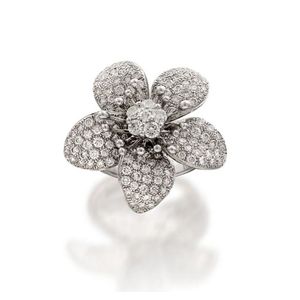Early 20th Century Diamond Pendant Necklace
You must be a subscriber, and be logged in to view price and dealer details.
Subscribe Now to view actual auction price for this item
When you subscribe, you have the option of setting the currency in which to display prices to $Au, $US, $NZ or Stg.
- Claw Set Jewellery - The description "claw set" in jewellery refers to a setting where the gemstone is held in place by metal prongs that resemble claws. These prongs are bent over the edges of the gemstone to secure it in the setting. This type of setting is commonly used for diamonds and other precious stones.
- Carat - A carat (abbreviated "ct") is a unit of measurement used to describe the weight of a diamond or other gemstone, and separately is a unit of measurement used to describe the weight of precious metals such as gold,.
For gemstones, one carat is equal to 0.2 grams or 200 milligrams. The weight of a diamond is one of the Four Cs (along with cut, colour, and clarity) that are used to determine a diamond's value.
It is important to note that a diamond's weight does not necessarily correspond to its size. A diamond's cut, which affects how well it reflects light, can make a diamond of a lower weight appear larger than a diamond of a higher weight. Additionally, the carat is not the only factor to determine the value of a diamond, other factors such as clarity, colour and cut are important too.
In the gold industry, the purity of gold is measured in carats (abbreviated "ct"), with 24 karats being pure gold and lower carat numbers indicating a lower purity level. So, for example, 18 carat gold is 18/24 or 75% pure gold, and 12 carat gold is 12/24 or 50% pure gold. - Openwork in Jewellery - Openwork, also known as pierced work, is a decorative technique used in jewellery making that involves removing or cutting out sections of metal from a piece of jewellery to create a pattern or design. This technique can be used in a wide range of jewellery styles, including necklaces, bracelets, earrings, and rings.
Openwork jewellery can be made using a variety of different techniques, including hand carving, sawing, and laser cutting. The design can be simple or complex, and can feature a range of different shapes and motifs, from delicate floral patterns to bold geometric designs.
One of the advantages of openwork jewellery is that it can add visual interest and depth to a piece without adding a lot of weight or bulk. This can be particularly appealing in larger pieces, such as necklaces and bracelets, where heavy materials can be uncomfortable to wear.
This item has been included into following indexes:
Visually similar items

18ct white gold and diamond ring, designed as a flowerhead, centring a cluster of brilliant-cut diamonds, framed by reticulated gold tendrils to five petals pave-set with brilliant-cut diamonds, the diamonds together stated to weigh 3.49 carats, size M.

A jade and diamond necklace, craved dyed lavender jade disc (3.8 cm) with fruit and flowers suspended from 18ct white gold articulated links set with 29 round brilliant cut diamonds totalling approx 0.50ct, to double belcher link chain with parrot clasp, l

18ct bi-colour gold, fancy light yellow diamond and diamond pendant necklace, of cluster design, centring a heart modified brilliant-cut natural fancy light yellow diamond weighing 1.84 carats, within a surround of brilliant-cut near colourless diamonds to

[South Australia] 8 facsimile volumes including, Horton James, T. Six Months in South Australia, with some account of port Philip and Portland Bay in Australia Felix, FOSLSA 1999 Ltd edn ed. 90/600 +Kinloch, A. The Murray River being a Journal of the voyag
